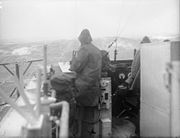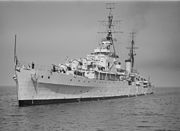| HMS Bellona (63) | |
|---|---|
 Bellona moored in October 1943 | |
| Career (United Kingdom) | |
| Name: | HMS Bellona |
| Namesake: | Bellona, Roman goddess of war |
| Builder: | Fairfield Shipbuilding and Engineering Company (Govan, Scotland) (Greenock, Scotland) |
| Laid down: | 30 November 1939 |
| Launched: | 29 September 1942 |
| Commissioned: | 29 October 1943 |
| Decommissioned: | June 1957 |
| Out of service: | Loaned to the Royal New Zealand Navy, 17 April 1946 |
| Reclassified: | In reserve between 1956 and 1957 |
| Motto: | 'Battle is our Business' |
| Fate: | Scrapped, Arrived at the Briton Ferry yard of Thomas W Ward Ltd, (Barrow-in-Furness, UK) on 5 February 1959 |
| Notes: | Pennant number 63 |
| Career (New Zealand) | |
| Name: | HMNZS Bellona |
| Commissioned: | 17 April 1946 |
| Out of service: | Returned to Royal Navy control in April 1956 |
| General characteristics | |
| Class & type: | Dido-class light cruiser |
| Displacement: |
5,950 tons standard 7,200 tons full load |
| Length: |
485 ft (148 m) pp 512 ft (156 m) oa |
| Beam: | 50.5 ft (15.4 m) |
| Draught: | 14 ft (4.3 m) |
| Propulsion: |
Parsons geared turbines Four shafts Four Admiralty 3-drum boilers 62,000 shp (46 MW) |
| Speed: | 32.25 knots (60 km/h) |
| Range: |
1,500 nmi (2,800 km) at 30 kn (56 km/h) 4,240 nmi (7,850 km) at 16 kn (30 km/h) 1,100 Long ton fuel oil |
| Complement: | 530 |
| Armament: |
Original configuration:
2 x 21 in (533 mm) triple torpedo tubes. |
| Armor: |
Original configuration:
|
HMS Bellona was the name ship of her sub-class of light cruisers for the Royal Navy. She was a modified Dido-class design with only four turrets but improved anti-aircraft armament. Entering service in 1943, the cruiser operated during World War II as an escort for the Arctic convoys, as a jamming ship to prevent the use of radio-controlled bombs and in support of the Omaha Beach landings.
In 1946 the cruiser was loaned to the Royal New Zealand Navy. Although not involved in the multi-ship mutiny, at the start of the month, 140 sailors elected to not return to the ship in protest at the poor pay and working conditions and how their colleagues had been treated. Fifty-two sailors were eventually marked as deserters while the others were charged with various lesser offences.
Bellona was returned to the Royal Navy in 1956. She did not reenter service and was scrapped two years later.
Construction[]
Bellona was a modified Dido-class design with only four turrets but improved anti-aircraft (AA) armament. She was built by Fairfield Shipbuilding and Engineering Company (Govan, Scotland), with the keel being laid down on 30 November 1939. She was launched on 29 September 1942 and commissioned on 29 October 1943. All of the Bellona class used the HACS high angle fire control system and they were all fitted with Remote Power Control, allowing the HACS to remotely control their 5.25-inch (133 mm) guns.
Bellona was named after the Roman Goddess of War. Her motto was 'Battle is our Business'.
Operational history[]
[]
Bellona participated in several Russian Convoys, both before and after D-Day. Prior to D-Day she took over the Channel patrol as a replacement for HMS Charybdis, which had been sunk off the Channel Islands by a radio-controlled bomb. On arrival at Plymouth, Bellona was fitted with equipment for jamming the radio signals that controlled the bombs. Bellona and seven destroyers were involved, including HMS Tartar. The codename for the patrol force was 'Snow White and the seven dwarfs'.
During the day the force anchored in Plymouth Sound, as air defence for Plymouth. At dusk, under cover of darkness and maintaining radio and radar silence, the force would proceed at full speed to the French coast to keep the German Narvik-class destroyers bottled up in Brest. The force would return to Plymouth by daylight. By day the RAF would patrol the Channel and by night, Plymouth.

A Force 12 plus gale was blowing when this picture was taken from the bridge as HMS Bellona plunged through mountainous seas on a convoy to Russia. Note the huge wave in front of the ship
On D-day Bellona's duty was to help to support Omaha Beach, in the American sector. The American battleships USS Texas and Arkansas were also there. As the army advanced, Bellona fired her guns inshore at targets spotted by aircraft and forward observation officers off-shore. On several occasions Bellona returned to Plymouth to get more ammunition and change her gun barrels because of wear. At night Bellona went close inshore to provide supporting fire.
In July 1944 Bellona covered the carrier raids against the German battleship Tirpitz but the following month was back in the Channel, attacking German convoy traffic in the Bay of Biscay and off the Brittany coast.
Bellona returned to northern waters, for the remainder of the war, sailing on Arctic convoys and accompanying carrier and cruiser sweeps along the Norwegian coastline before arriving in Copenhagen in time for the German surrender in May 1945.
After the war she was part of the 10th Cruiser Squadron until 1946 when she was loaned to the Royal New Zealand Navy.
[]

Bellona in 1947
During March and April 1947 Bellona was involved in training exercises with the Royal Australian Navy.[1] During gunnery practice a sailor, Gordon Patten, was injured and was sent to hospital for treatment where he remained for months. The cruiser returned to Devonport Naval Base in Auckland in late April and the crew were given a day's leave to attend Anzac Day services and events on Friday, 25 April.[2] Although the ship had missed the main mutiny at the start of the month, personnel from Bellona were concered about how their colleagues had been treated and during the afternoon, about 100 sailors assembled in Quay Street, Auckland and decided not to return to duty.[2] They compiled a list of three demands—that naval pay rates be increased to match the New Zealand Army and Royal New Zealand Air Force; that committees tasked with improving the welfare of the lower ranks be established; and that the sailors involved in the previous mutiny not be persecuted or punished.[2] Another 40 sailors mustering before boarding Bellona were recruited into the mutiny. In response, Bellona's captain sent the entire complement on leave for the weekend.[2]
On Monday 28 April, a letter listing the mutineers demands was presented to the captain with the intention that it be forwarded to the Naval Board.[2] Instead of addressing the complaints, the New Zealand Naval Board declared that any sailor who did not return to duty by the morning of Tuesday 29 April would be marked as Absent Without Leave.[3] By morning parade 52 men had failed to return.[3] Those sailors were marked as having deserted even though naval regulations meant that they had to be absent for seven days before being considered deserters.[3] Once marked, the sailors lost all unpaid pay and allowances.[3] The issuing of arrest warrants for the sailors was also considered, but the cruiser's captain dismissed the suggestion.[3] Between the date of the mutiny and 23 June, when Bellona sailed on her next deployment, another 32 men returned.[3] Various charges were laid against them, ranging from "wilfully disobeying a legal command" to "joining a mutiny not accompanied by violence" and the sailors were sentenced to periods of imprisonment up to 92 days.[3]
In 1951 the cruiser was taking part in a multinational exercise in Australian waters.[4] During the exercise a Hawker Sea Fury from the aircraft carrier HMAS Sydney accidentally fired four practice rockets into the superstructure of the New Zealand ship.[4] Only minor damage was caused and although an inquiry concluded that the pilot had unintentionally pressed the fire button, it was later found that certain signal frequencies transmitted by Sydney’s radios could trigger the aircraft's weapon-firing circuits.[4]
Bellona reverted to Royal Navy control after the transfer of HMS Royalist in 1956.
Fate[]
On 5 February 1959, she arrived at the Briton Ferry yard of Thomas W Ward Ltd to be broken up.
Citation[]
References[]
- Colledge, J. J.; Warlow, Ben (2006) [1969]. Ships of the Royal Navy: The Complete Record of all Fighting Ships of the Royal Navy (Rev. ed.). London: Chatham Publishing. ISBN 978-1-86176-281-8. OCLC 67375475.
- WWII cruisers
- HMS Bellona at Uboat.net
- Frame, Tom; Baker, Kevin (2000). Mutiny! Naval Insurrections in Australia and New Zealand. St. Leonards, NSW: Allen & Unwin. ISBN 1-86508-351-8. OCLC 46882022.
- Australian Naval Aviation Museum (ANAM) (1998). Flying Stations: a story of Australian naval aviation. St. Leonards, NSW: Allen & Unwin. ISBN 1-86448-846-8. OCLC 39290180.
External links[]
| Wikimedia Commons has media related to HMS Bellona (63). |
| |||||||||||||||||||
The original article can be found at HMS Bellona (63) and the edit history here.